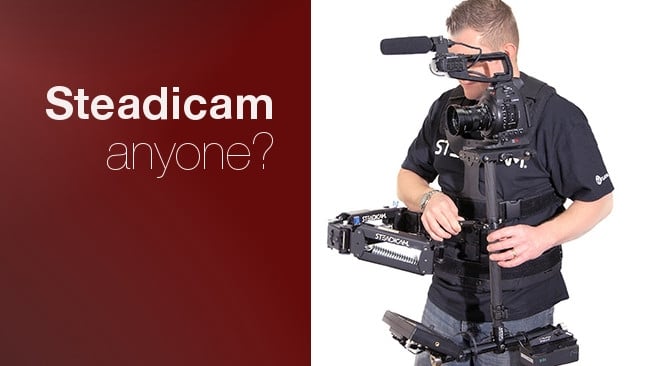
Replay: We first published this a few years ago, but it is still relevant. An interview that first appeared in the GTC's magazine, Zerb. Mel Noonan talks to Robin Thwaites and Danny Hallet of Tiffen International about the Steadicam line, including options, usage and how to get started.
The Steadicam system of camera stabilisation has had a huge impact on cinematography and television since Garrett Brown invented the first version forty years back. Steadicam has affected the way stabilised images are used in film and television work and has introduced a whole different genre of shooting. The latest big rig, the M-1, is the seventh generation of Steadicam and embodies all the advances that precision engineering, technological advances, innovation and operator feedback has been able to bring to it.
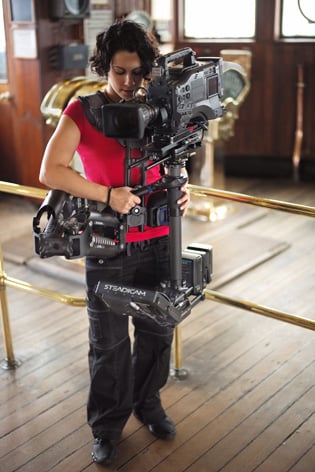 Steadicam instructor Kat Kallergis with the new Steadicam M-1 and the Fawcett Exovest at a Gold Workshop on board the Queen Mary, Long Beach, California.
Steadicam instructor Kat Kallergis with the new Steadicam M-1 and the Fawcett Exovest at a Gold Workshop on board the Queen Mary, Long Beach, California.
Robin Thwaites and Danny Hallett of Tiffen International have a combined forty years of experience in advising the best Steadicam solutions for those considering becoming owner operators and also training for Steadicam operation at all levels. Here they give an outline of the overall system, the higher end Steadicam kits and the various Steadicam workshop levels available for training.
"With Steadicam, it is highly desirable to be a camera operator first," says Robin,"or at the very least you need to have the right 'eye' and the ability to compose pictures. That is then compounded by the fact that you are using a moving camera and you have the freedom to move it through space. You suddenly add timing and parallax to your compositional technique, because, as with a crane, your foreground and background are going to move in relation to each other. You have to think about not only where images align, but also when, obviously crucial for music videos, but vital for narrative work, as well.
"You've got other things you can do, too, because Steadicam can move in all directions. You can control headroom or lens height just by moving the arm up and down, which can have a huge impact on composition."
Stabilisation
"If you think about hand held camera work, what you tend to see is a lot of micro movements. The camera will tend to move about its centre of gravity – it could be a roll, pan, or tilt. You often see small variations which you can't easily eliminate. By taking the centre of gravity outside of the camera and putting it below the gimbal on the Steadicam, you get rid of those small movements. That's a clever thing about Steadicam, which goes right back to Garrett Brown's original design.
"There are other types of stabilisers – optical stabilisers and gyro stabilisers and gimbals that basically stabilise either the image or the whole camera, but the nature of the beast means that if you were asked to do a whip pan or accurately hold headroom (especially on a tight lens), you'd probably have difficulty. Steadicam can do that – it is second nature."
Steadicam's components
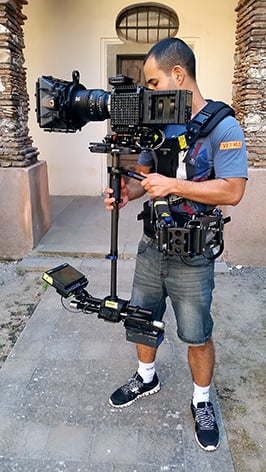 Vitali Agronov from the Israel Film School with the Steadicam Zephyr
Vitali Agronov from the Israel Film School with the Steadicam Zephyr
Location: Terre di Cinema workshop in Sicily
"If you divide the Steadicam into three parts, you've got the sled, the arm and the vest.
"The sled is really just a post with the camera on the top and monitor and batteries on the bottom (although they can be reversed for what we call low mode for shooting with the camera near the ground). It's the part that carries the camera and all the accessories that go with it. You can't put your eye on the camera viewfinder, so you need a separate monitor which we locate somewhere down low on the sled so that you can also see where you're walking. It also carries the batteries that are used to power the monitor and may also be used to power the camera and ancillary systems.
"It's complex, because of the additional things that people need to use, like follow focus and radio transmitters. They need reliable power and reliable video to go from the camera down to the monitor and then potentially the recording systems. The main thing about the sled is it's got to be rigid and easily adjustable and something that the operator can relate to.
"The arm is the clever bit that attaches the sled to your body and not only allows you to take out the shocks when you move around, but also to change the height of the camera for framing. On the G70x arm, we've got just under a metre of height change.
"The vest is the part you wear that transfers the weight into your body, on to your skeletal structure. It's designed to carry the weight in a way that's best for the body and allows you to breathe and move around."
Gimbal
"A gimbal is simply a device where you suspend something and it can move on three axes with the minimum friction and is the heart of the Steadicam, allowing the operator to frame the shot with maximum isolation between the human body and camera lens.
"What some people are now calling gimbals probably should be referred to as 'brushless motor stabilised gimbals'. Steadicam does a very different thing. It is tactile and intuitive, making it feel more connected to the composition process. Electronic systems always introduce a little remote feeling, whereas Steadicam invites the viewer into the image."
The arm
"A very clever part of the Steadicam is the bit that connects the rig to your body, which we call the 'arm'. If you had the dumb gimbal as it stands, as on our lightweight Steadicams like the Smoothee, you can hold it and use your arm to take the shock out.
"Of course, if you are carrying a heavy camera payload, your arm isn't strong enough, so you need a sprung suspension system which attaches it to your body, hopefully in the most efficient way that it can. It should be free moving enough so that you can also use that to adjust the height of the camera with minimal hand pressure (often referred to as Iso-Elastic). The G70x is the latest arm for the high end rigs."
Starting with Steadicam
"If you're considering starting Steadicam, you need to begin by thinking what camera you are likely to have to carry on the rig. To us, a camera is something which produces a picture and has a weight. The Steadicam doesn't care whether it's 4K, 6K, whatever, if it has some mass and produces a picture, that's what we need to know first. All Steadicams are rated on what weight they will carry and that weight must be of the camera, lens and all of the accessories. We would call it the camera payload.
"As an example, the Pilot2 will carry a 4.5 kilogram camera payload, the Zephyr will take a 10 kilo camera payload and the Archer will take 14.5 kilos. The bigger rigs like the Shadow and the M-1 will take 20 to 22 kilos.
"To put this into context, the Pilot would typically be carrying DSLRs and lightweight video cameras – think small promotional, corporate and wedding videographers. It's designed for that and works very well in those areas.
"The Zephyr will take 10 Kilos and there are quite a lot out there. It's used often in small commercial type productions, music videos, all that sort of thing. It's a very good rig and you could happily put an ENG camera on there of 7 or 8 kilos. The Alexa starts an 9 kilos, but with the camera plate, lens and all the accessories, next thing you know you're at 14 to 15 kilos, so out of the question on a Zephyr.
"The Archer would be very happy with an F55 or a RED and with one of the more lightweight Arri packages; the Amira for sure, but the Alexa XT has got heavier. If you are using compact primes, probably OK, but if you get to the location and it's not a compact prime and you're shooting anamorphic, you're probably in trouble.
"The Archer also sits very well in the TV/ OB /sports type scenario, because it's light enough to wear for long periods. However, a lot of the TV companies will buy one of the bigger rigs to be safe enough, in case they want to use it for studio work with a prompter also.
"And then the Shadow and the M-1 will take anything that you would really want to carry!"
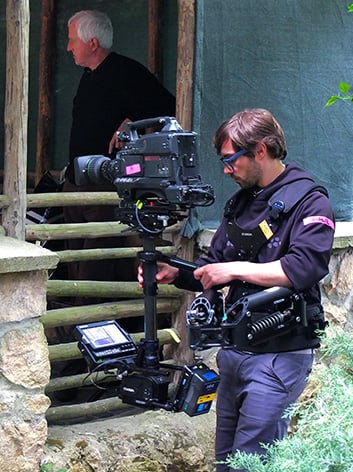 Steadicam owner op Charlie Cowper with the Shadow
Steadicam owner op Charlie Cowper with the Shadow
That figure in the background is none other than Steadicam inventor Garrett Brown.
The Steadicam workshops – is Steadicam right for you?
"To anyone considering taking up Steadicam or adding the skill to their arsenal, then it's really a good idea to start by going to a Steadicam workshop," says Robin.
"Even if you are an experienced camera operator, they're a great thing, because you've got two aspects – first of all is the technical side – because unless you can set up and balance the Steadicam, you don't have a hope. The balancing and setting up tends to be a personal feel thing as well so, unless you've had the opportunity to experience what it should feel like, you don't know how to set it up to make it feel the way you'd like it to feel. It's very much a Catch 22 thing.
"Then, you've got to learn how to use your body to carry it around the best way – that's the other half of the equation, because obviously you're carrying this load and I wouldn't say it's an athletic thing, but it is certainly a physical activity – it's a very centred thing. It's to do with poise and balance as much as strength."
"I would agree that the Steadicam workshops are the best way to find out if Steadicam is right for you," adds Danny Hallett."We've got three flavours of workshop, Bronze, Silver and Gold.
"The Bronze workshop is 2 day non-residential and we only use rigs up to Zephyrs.
"Silver workshops we use all rigs and it's a 3 day non residential course.
"The Gold workshop is something special because we use all the rigs; it's 5 days, it's residential, it's full board, and it's a kind of total immersion experience which puts you alongside some of the best known operators as your instructors, right there to answer your questions. It's about techniques and we get into the choreography of shots and moves, and linking them together.
"With the Silver and the Bronze, we teach as much as we can in the given time. We're very strong on people learning the basics, so what we are doing is teaching people how to practice, and not practice badly; it is so important that they practice correctly. Also, it's fundamental that you learn how to set up and balance the Steadicam before you start to use it.
"All the workshops are going to require practice afterwards – it's the beginning of a road, not the end of a road.
"The other thing is, particularly the Bronze and Silver are a relatively inexpensive way of finding out whether Steadicam is right for you.
"We have workshops in the UK, we've got the American ones and in Asia and Australia, too.
"You'll find them listed on the www.flysteadicam.com website."
Work, purchasing and finance
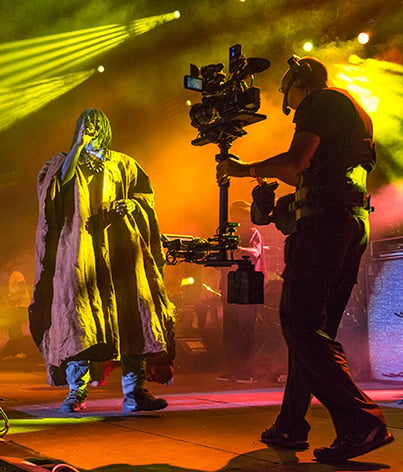 Steadicam owner op Emmanuel Dinh working in Reunion with his Archer 2 Steadicam
Steadicam owner op Emmanuel Dinh working in Reunion with his Archer 2 Steadicam
"I'd say that most operators who are half way good have plenty of work," says Danny.
"If you're already a camera operator and you're thinking of going for Steadicam, obviously one of the concerns is 'how do I approach this in a way that it's going to be financially advantageous'?
"What you have to remember is that most of your existing clients could well be your clients for Steadicam, as well. If you've already got a good client list – they're going to be interested if you say you've been trained in Steadicam or are buying one or whatever, that's quite a big deal.
"If you're starting off fresh, with no experience, and don't have the client list, you've got to start knocking on doors and selling yourself.
"Although we are very hot on the technical training and we love the idea that it's got to be artistic – not all the most successful Steadicam operators are the best Steadicam operators – but they may be the best business people.
"If you've got the both talents, then it's a winning combination.
"With Steadicam, if you consider buying it on a lease, say over three years, with one of the top rigs, and you go out at the correct rate rather than a cut down rate, you could probably work three days a month and have it paid off at the end of the three year period. If you are actually working five to six days per month, then you're paying the lease back much faster – we often find that 18 months is a common break-even point.
"Steadicam is a great creative tool and, while the workload can be immense, it is uniquely satisfying in that it that often allows more creative input from the operator than just about any other role in production."
First published in Zerb, the journal of the GTC. For more information on Tiffen's Steadicam line, visit www.flysteadicam.com.
Tags: Production


Comments